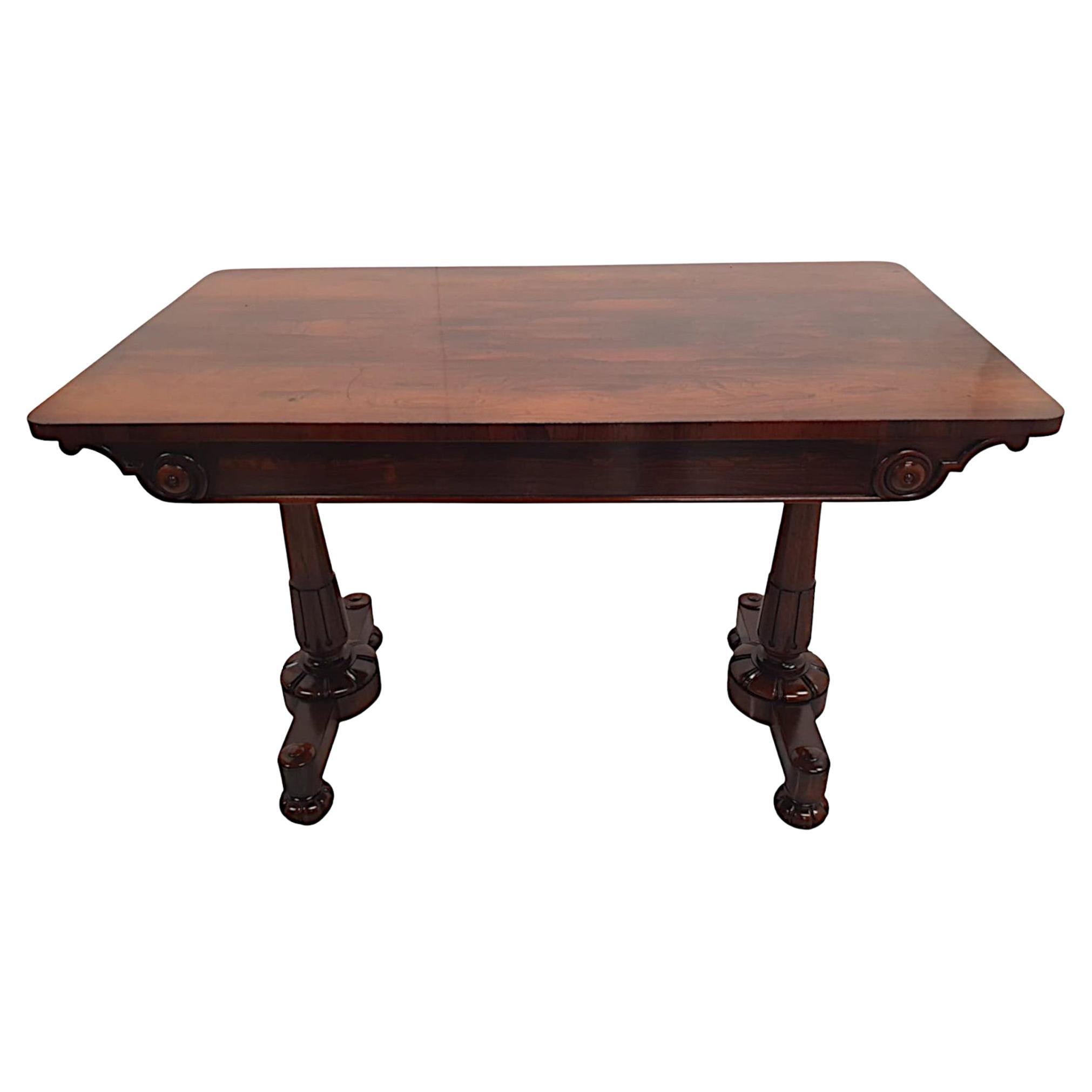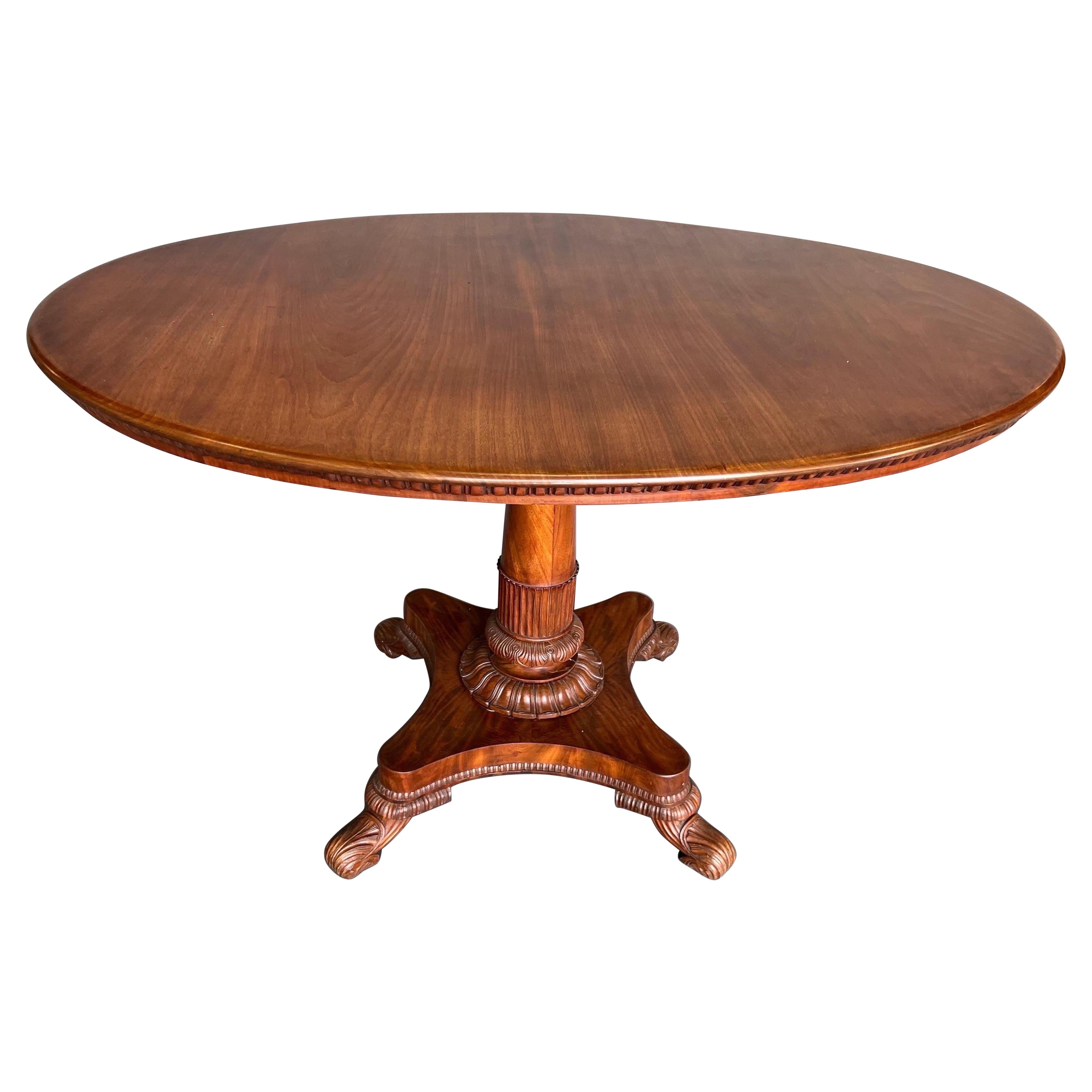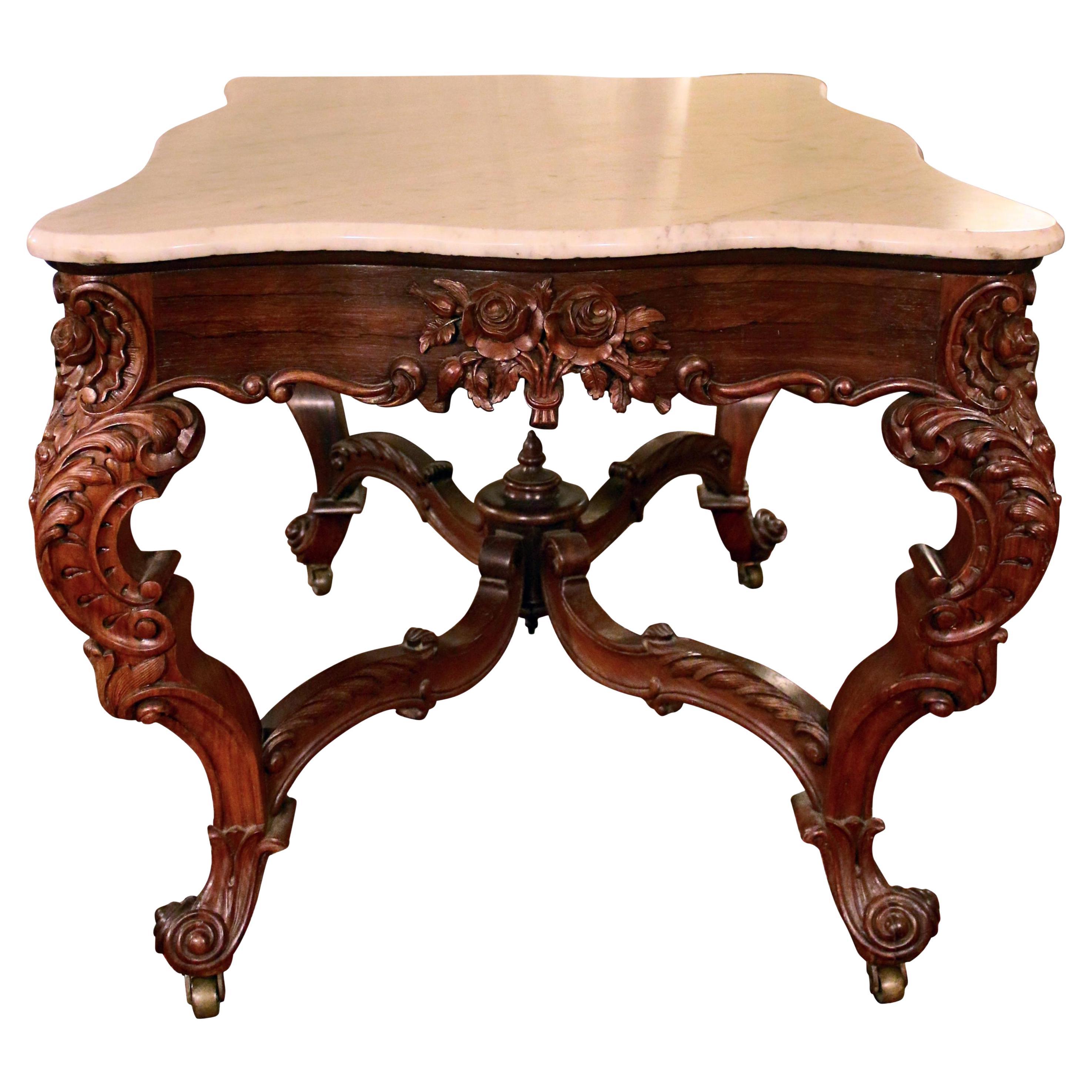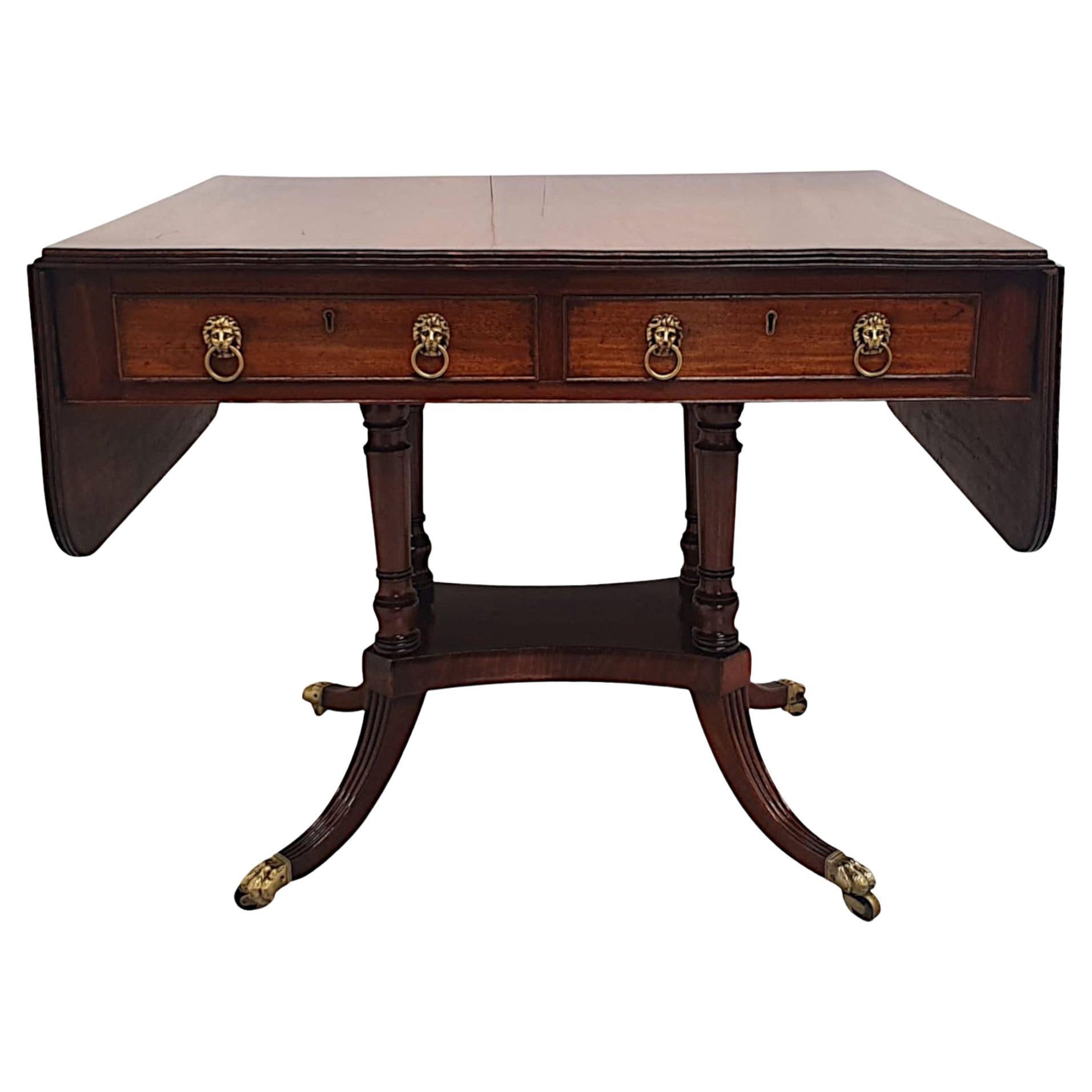Items Similar to A Fine 19th Century Irish Library Table Attributed to Gillingtons of Dublin
Want more images or videos?
Request additional images or videos from the seller
1 of 11
A Fine 19th Century Irish Library Table Attributed to Gillingtons of Dublin
About the Item
A very fine 19th Century Irish solid mahogany library table with a Strahan storage label and drawers numbered but attributed to 'Gillingtons of Dublin', of exceptional quality and finely hand carved with gorgeously rich patination. The well figured, fine grained and moulded top of rectangular form with canted corners is supported above a simple, shaped and panelled cockbeaded two drawer frieze with moulded pulls and brass escutcheons. Raised over a pair of elegant, slender reverse tapering, column end supports with beautiful concentric motif detail, conjoined with finely ring turned stretcher above fluted sabre leg, terminating on scroll foot and casters.
Mahogany Type: ‘Santos Mahogany’
- Dimensions:Height: 29 in (73.66 cm)Width: 56.25 in (142.88 cm)Depth: 30.5 in (77.47 cm)
- Materials and Techniques:Bronze,Mahogany
- Place of Origin:Ireland, Republic of
- Period:19th Century
- Date of Manufacture:19th Century
- Condition:Refinished. Wear consistent with age and use.
- Seller Location:Dublin, IE
- Reference Number:
About the Seller
5.0
Platinum Seller
These expertly vetted sellers are 1stDibs' most experienced sellers and are rated highest by our customers.
Established in 1998
1stDibs seller since 2021
55 sales on 1stDibs
Typical response time: <1 hour
- ShippingRetrieving quote...Ships From: Dublin, Ireland
- Return PolicyA return for this item may be initiated within 14 days of delivery.
More From This SellerView All
- A Very Fine 19th Century Library TableBy Holland & SonsLocated in Dublin, IEA very fine 19th Century fruitwood library table by the London maker 'Holland', of exceptional quality and fabulously hand carved with gorgeously rich patination. The well figured, ...Category
Antique 19th Century English Tables
MaterialsFruitwood
- A Very Rare and Fine Irish Georgian Sofa Table Stamped Gillington of DublinLocated in Dublin, IEA very rare and fine Irish Georgian mahogany sofa table stamped 'Gillington of Dublin', finely hand carved and of exceptional quality with...Category
Antique Early 19th Century Irish Georgian Sofa Tables
MaterialsBrass
- Stunning 19th Century Irish Console TableLocated in Dublin, IEA stunning 19th century Irish solid mahogany console, side or hall table, beautifully hand carved with rich patination and grain. The moulded rim top raised over shaped apron with ce...Category
Antique 19th Century Irish Console Tables
MaterialsMahogany
- Fabulous 19th Century Library Desk or TableLocated in Dublin, IEA fabulous 19th century fruitwood library table desk finely hand carved with gorgeously rich grain and patination. The moulded top of rectangular form raised over scalloped frieze ab...Category
Antique 19th Century English Desks and Writing Tables
MaterialsBrass
- Very Fine 19th Century Console or Hall TableLocated in Dublin, IEA very fine 19th century walnut and mahogany console or hall table. Fabulously hand carved with rich patination and grain, the moulded, serpentine top with gallery back rail is raise...Category
Antique 19th Century English Console Tables
MaterialsBrass
- Very Fine Early 19th Century Regency Sofa TableLocated in Dublin, IEA very fine early 19th century Regency mahogany sofa table, of gorgeous quality and beautifully hand carved with rich patination and grain. The well figured, moulded, reeded edge top...Category
Antique Early 19th Century English Regency Sofa Tables
MaterialsBrass
You May Also Like
- Early 19th Century Irish Amboyna Centre Table Stamped Gillingtons of DublinLocated in Dublin, IEThe circular top veneered in extremely well figured amboyna having a cross banded outer border. The top supported on a octagonal column, similarly veneered in amboyna, resting on a t...Category
Antique 1820s Irish Regency Center Tables
MaterialsAmboyna
- Fine 19th Century Irish Regency Period Oval Top Mahogany TableLocated in Charleston, SCFine 19th century Irish Regency period oval breakfast table. Good color and great quality timbers used in this period Irish table. Oval top over turned p...Category
Antique Early 19th Century Irish Regency Center Tables
MaterialsMahogany
- 19th Century Rosewood Center Table Attributed to Joseph MeeksBy Joseph MeeksLocated in Savannah, GARococo Revival center table attributed to the prestigious New York firm of Joseph Meeks. Heavily hand carved rosewood featuring floral bouquets and rosettes, graceful serpentine legs...Category
Antique 1850s American Rococo Revival Serving Tables
MaterialsMarble
- Rosewood 19th Century Library Hall TableLocated in London, GBA fine, early 19th century rosewood library table in the manner of the architect and designer Richard Bridgens (1785-1846). The finely figured top with a moulded edge above a carved ...Category
Antique 1840s English Early Victorian Tables
MaterialsRosewood
- 19th Century Walnut Serpentine Card Table Firmly Attributed to GillowsBy Gillows of Lancaster & LondonLocated in London, GBA walnut serpentine card table firmly attributed to Gillows Constructed using finely figured Circassian walnut, dressed with gilt bronze mounts; rising from slender kingwood banded ...Category
Antique Mid-19th Century English Louis XV Card Tables and Tea Tables
MaterialsBronze, Ormolu
- 19th Century Coromandel and Inlaid Table Attributed to Jackson & GrahamBy Jackson & GrahamLocated in London, GBA magnificent library table Attributed to Jackson & Graham Of free standing rectangular form, constructed in coromandel, with inlays in thuya, ebony, boxwood, and honeysuckle; the fluted legs rising from square brass castor-shod feet; the frieze housing two lockable drawers fitted with rare ‘tamper proof’ Chubb locks and having quadrant moulded cedar lined interiors; the platform having a central panel of beautifully chosen matched coromandel veneers, with an outer guard border of a running pattern of stylised anthemions; the ebony edges having a thumb nail moulding, circa 1865 The firm of Jackson & Graham established in 1836 by Thomas Jackson and Peter Graham at 37 Oxford Street London, and for the next fifty years produced predominately high quality furniture and represented Britain at many of the international exhibitions. Their clients included Queen Victoria, Napoleon III, the Grand Khedive of Cairo and the royal palace in Siam. They were particularly noted for their fine marquetry work, the use of Wedgwood plaques, rare woods, and fine casting of bronze mounts. They engaged the leading designers of the period, inter alia, Owen Jones, Bruce Talbert, Alfred Lorimer and Eugene Prignot. In the mid-1850s the workforce was recorded as 250, and by 1875, the company was employing 600 workers. They were feted exhibitors at many of the Great Exhibitions of the 19th century, and frequent prize winners. At the Paris International Exhibition of 1878, the furniture jury noted of them ‘ the workmanship is so perfect that even with the aid of a magnifying glass scarcely the slightest imperfection is to be found’. In 1885 the company was absorbed by Collinson and Lock, who continued their standard of excellence. Charles Chubb was apprenticed as a blacksmith before starting business as a ships’ ironmonger in Winchester. Jeremiah soon joined the business, and by 1818 the brothers had branched out into lockmaking, founding the famous Chubb Company. The business really got started when Jeremiah Chubb patented his new ‘detector lock’ in 1818. The lock was constructed so that if someone tried to pick it or open it with the wrong key it became inoperable. To make the lock work again the owner had to use a special key supplied with the lock. The aim of the detector lock was to prevent burglaries, and to warn the owner that someone had tried to break into their property. The lock soon became popular, and sales of the Chubbs’ products increased even more when they won a government competition to design a lock that could only be opened using its own key. After the invention of the detector lock, the Chubbs decided to move to Wolverhampton, which already had an established lock making industry. By 1838 they were making 28,000 locks a year at their Wolverhampton factory. Another product was added to the Chubb range in 1835 when a patent was taken out for a burglar resistant safe, and in 1837 the Chubb safe...Category
Antique 19th Century English Tables
MaterialsBrass
Recently Viewed
View AllMore Ways To Browse
Antique Bronze Drawer Pull
Antique Ring Drawer Pulls
Two Drawer Turned Leg Table
Library End Table
Library Table With Drawers
Mahogany Library Table
Carved Leg Library Table
Two Drawer Stretcher Table
Library Table Drawer
Antique Irish Carved Tables
Antique Library Table Mahogany
Antique Mahogany Library Table
Ireland Ring
Antique Library Table With Drawer
Rectangular Library Tables
Library Table Pair
Pair Of Library Tables
19th Century Santos





